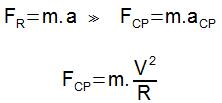When an object performs a uniform circular motion, its velocity value is constant, but this magnitude undergoes changes in its direction and direction.

Note in the image above that the velocity vector, in orange, undergoes changes in direction and direction along the circular path. THE greatness responsible for the change in the direction and direction of velocity during the execution of a circular movement is the centripetal acceleration, vector highlighted in green. This quantity is defined by the following equation:

Centripetal acceleration results from the ratio of the square of the velocity (V) of a body to the radius (R) of the executed circular path.
Centripetal force
The term centripetal means that which points to the center. Notice in the previous figure that the vectors in green, which represent the centripetal acceleration, all point to the center and generate the change in the direction and direction of velocity.
Associated with centripetal acceleration, we can define by Newton's second law
the centripetal force. This force is responsible for keeping the bodies stuck in the circular path.
The terms of the centripetal force equation are:
FCP = Centripetal force (N – newtons)
m = Body mass (kg)
V = Body speed (m/s)
R = Circular path radius (m)
As well as acceleration, the centripetal force points to the center of the circular path. When a vehicle makes a turn on a freeway, the frictional force between the tires and the asphalt acts as a centripetal force and keeps the mobile fixed to the circular path. Bald tires and a wet road reduce friction and increase the risk of the vehicle losing control and going off the road during a turn.
Is there centrifugal force?
When we are riding in a car and the vehicle makes a right turn, we notice that our body is automatically taken to the left side, showing the tendency to exit the curve made by the vehicle. Apparently, a force pulls it out of the trajectory, hence the idea of centrifugal force.
However, it is worth saying that the centrifugal force does not exist. What many call strength, actually, is the inertia. During the execution of the turn, the body of a passenger tends, by inertia, to keep the movement in the previous direction and, thus, the sensation of being pushed out of the circular trajectory arises.

The dotted line in the image above shows the trajectory of an object if it abandoned circular motion at exactly the indicated point. There is no centrifugal force that makes the object “run away” from the circular path, as the indicated path results from the object's inertia.
By Joab Silas
Graduated in Physics
Source: Brazil School - https://brasilescola.uol.com.br/o-que-e/fisica/o-que-e-forca-centripeta.htm

